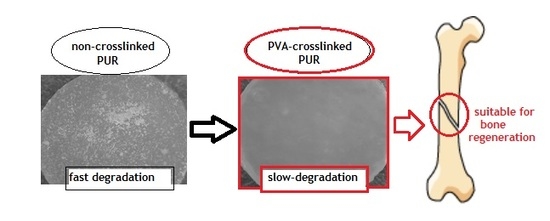Polyurethanes Crosslinked with Poly(vinyl alcohol) as a Slowly-Degradable and Hydrophilic Materials of Potential Use in Regenerative Medicine
Abstract
:1. Introduction
2. Experimental
2.1. Materials and Methods
2.1.1. Synthesis of Polyurethanes (PURs)
2.1.2. Fourier Transform Infrared Spectroscopy (FTIR)
2.1.3. Swelling and Crosslink Density
2.1.4. Static Contact Angle (CA)
2.1.5. Mechanical Properties
Tensile Strength (TSb) and Elongation at Break (εb)
Hardness
2.1.6. Long-Term Interactions with Selected Media
2.1.7. Optical Microscopy
2.1.8. Calcification Study
2.1.9. Hemocompatibility
2.1.10. Biocompatibility
In Vitro Cytocompatibility
Cell Adhesion
3. Results
3.1. Fourier Transform Infrared Spectroscopy (FTIR)
3.2. Swelling and Crosslink Density
3.3. Static Contact Angle Determination
3.4. Mechanical Properties
3.5. Long-Term Interactions with Selected Media
3.6. Optical Microscopy
3.7. Calcification Study
3.8. Hemocompatibility Study
3.9. Biocompatibility
4. Discussion
5. Conclusions
Acknowledgments
Conflicts of Interest
References
- Kucinska-Lipka, J.; Gubanska, I.; Janik, H.; Sienkiewicz, M. Fabrication of polyurethane and polyurethane based composite fibres by the electrospinning technique for soft tissue engineering of cardiovascular system. Mater. Sci. Eng. C 2015, 46, 166–176. [Google Scholar] [CrossRef] [PubMed]
- Janik, H.; Sienkiewicz, M.; Kucinska-Lipka, J. Polyurethanes. In Handbook of Thermoset Plastics, 3rd ed.; Goodman, S.H., Dodiuk-Kenig, H., Eds.; Elsevier: Amsterdam, The Netherlands, 2014; pp. 253–295. [Google Scholar]
- Kucinska-Lipka, J.; Gubanska, I.; Janik, H.; Pokrywczynska, M.; Drewa, T. L-ascorbic acid modified poly(ester urethane)s as a suitable candidates for soft tissue engineering applications. React. Funct. Polym. 2015, 97, 105–115. [Google Scholar] [CrossRef]
- Kucinska-Lipka, J.; Gubanska, I.; Strankowski, M.; Cieśliński, H.; Filipowicz, N.; Janik, H. Synthesis and characterization of cycloaliphatic hydrophilic polyurethanes, modified with L-ascorbic acid, as materials for soft tissue regeneration. Mater. Sci. Eng. C 2017, 75, 671–681. [Google Scholar] [CrossRef] [PubMed]
- Janik, H.; Marzec, M. A review: Fabrication of porous polyurethane scaffolds. Mater. Sci. Eng. C 2015, 48, 586–691. [Google Scholar] [CrossRef] [PubMed]
- Fujimoto, K.L.; Guan, J.; Oshima, H.; Sakai, T.; Wagner, W.R.; Hill, M. In Vivo Evaluation of a Porous, Elastic, Biodegradable Patch for Reconstructive Cardiac Procedures. Ann. Thorac. Surg. 2007, 83, 648–654. [Google Scholar] [CrossRef] [PubMed]
- Liljensten, E.; Gisselfalt, K.; Edberg, B.; Bertilsson, H.; Flodin, P.; Nilsson, A.; Lindahl, A.; Peterson, L. Studies of polyurethane urea bands for ACL reconstruction. J. Mater. Sci. Mater. Med. 2002, 13, 351–359. [Google Scholar] [CrossRef] [PubMed]
- Li, Y.; Thouas, G.A.; Chen, Q.; Chen, Q. Biodegradable soft elastomers: synthesis/properties of materials and fabrication of scaffolds. RSC Adv. 2012, 2, 8229–8242. [Google Scholar] [CrossRef]
- Niu, Y.; Zhu, Y.; Gao, R.; Yu, W.; Li, L.; Xu, K. Synthesis, Characterizations and Biocompatibility of Novel Block Polyurethanes Based on Poly (lactic acid) (PLA) and Poly (3-hydroxybutyrate-co-4-hydroxybutyrate). J. Inorg. Organomet. Poly. Mater. 2015, 25, 81–90. [Google Scholar] [CrossRef]
- Barrioni, B.R.; De Carvalho, S.M.; Oréfice, R.L.; De Oliveira, A.A.R.; Pereira, M.D.M. Synthesis and characterization of biodegradable polyurethane films based on HDI with hydrolyzable crosslinked bonds and a homogeneous structure for biomedical applications. Mater. Sci. Eng. C 2015, 52, 22–30. [Google Scholar] [CrossRef] [PubMed]
- Gorna, K.; Gogolewski, S. Biodegradable polyurethanes for implants. II. In vitro degradation and calcification of materials from poly(ɛ-caprolactone)–poly(ethylene oxide) diols and various chain extenders. J. Biomed. Mater. Res. 2002, 60, 592–606. [Google Scholar] [CrossRef] [PubMed]
- Joshi, R.R.; Underwood, T.; Frautschi, J.R.; Phillips, R.E.; Schoen, F.J.; Levy, R.J. Calcification of polyurethanes implanted subdermally in rats is enhanced by calciphylaxis. J. Biomed. Mater. Res. 1996, 31, 201–207. [Google Scholar] [CrossRef]
- Schlickewei, C.; Verrier, S.; Lippross, S.; Pearce, S. Interaction of Sheep Bone Marrow Stromal Cells with Biodegradable Polyurethane Bone Substitutes. Macromol. Symp. 2007, 253, 162–171. [Google Scholar] [CrossRef]
- Gebelin, C.G. Advances in Biomedical Polymers; Springer: Berlin, Germany, 1987. [Google Scholar]
- Thoma, R.J. Poly (ether) Urethane Reactivity with metal-ion in calcification and environmental stress cracking. J. Biomater. Appl. 1987, 1, 449–486. [Google Scholar] [CrossRef] [PubMed]
- Podporska-Carroll, J.; Ip, J.W.Y.; Gogolewski, S. Biomaterialia Biodegradable poly (ester urethane) urea scaffolds for tissue engineering : Interaction with osteoblast-like MG-63 cells. Acta Biomater. 2014, 10, 2781–2791. [Google Scholar] [CrossRef] [PubMed]
- Gogolewski, S.; Gorna, K.; Turner, A.S. Regeneration of bicortical defects in the iliac crest of estrogen-deficient sheep, using new biodegradable polyurethane bone graft substitutes. J. Biomed. Mater. Res. Part A 2006, 77, 802–810. [Google Scholar] [CrossRef] [PubMed]
- Gogolewski, S.; Gorna, K. Biodegradable polyurethane cancellous bone graft substitutes in the treatment of iliac crest defects. J. Biomed. Mate. Res. 2007, 80, 94–101. [Google Scholar] [CrossRef] [PubMed]
- Chiono, V.; Pulieri, E.; Vozzi, G.; Ciardelli, G.; Ahluwalia, A.; Giusti, P. Genipin-crosslinked chitosan/gelatin blends for biomedical applications. J. Mater. Sci.: Mater. Med. 2008, 19, 889–898. [Google Scholar] [CrossRef] [PubMed]
- Ma, L.; Gao, C.; Mao, Z.; Zhou, J.; Shen, J.; Hu, X.; Han, C. Collagen/chitosan porous scaffolds with improved biostability for skin tissue engineering. Biomaterials 2003, 24, 4833–4841. [Google Scholar] [CrossRef]
- Tan, H.; Chu, C.R.; Payne, K.A.; Marra, K.G. Injectable in situ forming biodegradable chitosan-hyaluronic acid based hydogels for cartilage tissue engineering. Biomaterials 2009, 30, 2499–2506. [Google Scholar] [CrossRef] [PubMed]
- Hassan, C.M.; Peppas, N.A. Structure and Applications of Poly (vinyl alcohol) Hydrogels Produced by Conventional Crosslinking or by Freezing/Thawing Methods. In Biopolymers PVA Hydrogels, Anionic Polymerisation Nanocomposites; Springer: Berlin, Germany, 2015; pp. 37–65. [Google Scholar]
- Devine, D.M.; Higginbotham, C.L. The synthesis of a physically crosslinked NVP based hydrogel. Polymer 2003, 44, 7851–27860. [Google Scholar] [CrossRef]
- Kita, M.; Ogura, Y.; Honda, Y.; Hyon, S.H.; Cha, W.; Ikada, Y. Evaluation of polyvinyl alcohol hydrogels as soft contact lens material. Graefe’s Arch. Clin. Exp. Ophtalmol. 1990, 228, 533–537. [Google Scholar] [CrossRef]
- Burczak, K.; Gamian, E.; Kochman, A. Long-term in vivo performance and biocompatibility of poly (viny1 alcohol) hydrogel macrocapsules for hybrid- type artificial pancreas. Biomaterials 1996, 17, 2351–2356. [Google Scholar] [CrossRef]
- Young, T.; Yao, N.; Chang, R.; Chen, L. Evaluation of asymmetric poly (vinyl alcohol) membranes for use in artificial islets. Biomaterials 1996, 17, 2139–2145. [Google Scholar] [CrossRef]
- Hing, K.A. Bone Repair in the Twenty-First Century: Biology, Chemistry or Engineering? Philos. Trans. R. Soc. Lond. A Math. Phys. Eng. Sci. 2004, 362, 2821–2850. [Google Scholar] [CrossRef] [PubMed]
- Maruoka, S.; Matsuura, T.; Kawasaki, K.; Okamoto, M.; Yoshiaki, H. Biocompatibility of Polyvinylalcohol Gel as a Vitreous Substitute. Curr. Eye Res. 2006, 31, 599–606. [Google Scholar] [CrossRef] [PubMed]
- Noguchi, T.; Yamamuro, T.; Okayt, M.; Kumar, P.; Kotourayt, Y. Poly (viny1 Alcohol) Hydrogel As an Artificial Articular Cartilage: Evaluation of Biocompatibility. J. Appl. Biomater. 1991, 2, 101–107. [Google Scholar] [CrossRef] [PubMed]
- Oka, M.; Ushio, K.; Kumar, P.; Ikeuchi, K.; Hyon, S.H.; Nakamura, T.; Fujita, H. Development of artificial articular cartilage. Proc. Inst. Mech. Eng. Part H J. Eng. Med. 2015, 214, 59–68. [Google Scholar] [CrossRef] [PubMed]
- Oka, M. Biomechanics and repair of articular cartilge. J. Orthop. Sci. 2001, 6, 448–456. [Google Scholar] [CrossRef] [PubMed]
- Stammen, J.A.; Williams, S.; Ku, D.N.; Guldberg, R.E. Mechanical properties of a novel PVA hydrogel in shear and unconfined compression. Biomaterials 2001, 22, 799–806. [Google Scholar] [CrossRef]
- Święczkowski, W.; Ku, D.N.; Bersee, H.E.N.; Kurzydłowski, K.J. An elastic material for cartilage replacement in an arthritic shoulder joint. Biomaterials 2006, 27, 1534–1541. [Google Scholar] [CrossRef] [PubMed]
- Kobayashi, M.; Chang, Y.; Oka, M. A two year in vivo study of polyvinyl alcohol-hydrogel (PVA-H) artificial meniscus. Biomaterials 2005, 26, 3243–3248. [Google Scholar] [CrossRef] [PubMed]
- Kobayashi, M.; Toguchida, J.; Oka, M. Preliminary study of polyvinyl alcohol-hydrogel (PVA-H) artificial meniscus. Biomaterials 2003, 24, 639–647. [Google Scholar] [CrossRef]
- Baker, M.I.; Walsh, S.P.; Schwartz, Z.; Boyan, B.D. A review of polyvinyl alcohol and its uses in cartilage and orthopedic applications. J. Biomed. Mater. Res. Part B Appl. Biomater. 2012, 100, 1451–1457. [Google Scholar] [CrossRef] [PubMed]
- Kucińska-Lipka, J.; Janik, H.; Stelmasik, A.; Janowicz, M. Method for Preparing Polyurethane Segment, Involves Pre-Polymerizing Polymer in Solution for Prolongation, and Combining Oligomer Flexible Segment as Component with Diisocyanate under Reduced Pressure, Followed by Reacting with Modifier. PL 223226 B1, 30 October 2016. [Google Scholar]
- Bonakdar, S.; Emami, S.H.; Shokrgozar, M.A.; Farhadi, A.; Ahmadi, S.A.H.A.; Amanzadeh, A. Preparation and characterization of polyvinyl alcohol hydrogels crosslinked by biodegradable polyurethane for tissue engineering of cartilage. Mater. Sci. Eng. 2010, 30, 636–643. [Google Scholar] [CrossRef]
- Shokrgozar, M.A.; Bonakdar, S.; Dehghan, M.; Emmami, S.H.; Montazeri, L.; Azari, S.; Rabbani, M. Biological evaluation of polyvinyl alcohol hydrogel croslinked by polyurethane chain for cartilage tissue engineering in rabbit model. J. Mater. Sci. Mater. Med. 2013, 24, 2449–2460. [Google Scholar] [CrossRef] [PubMed]
- Petrini, P.; Fare, S.; Piva, A.; Tanzi, M.C. Design, synthesis and properties of polyurethane hydrogels for tissue engineering. J. Mater. Sci. Mater. Med. 2003, 14, 683–686. [Google Scholar] [CrossRef]
- Datta, J.; Włoch, M. Preparation, morphology and properties of natural rubber composite filled with untreated short jute fibers. Polym. Bull. 2017, 74, 763–782. [Google Scholar] [CrossRef]
- Desai, S.; Thakore, I.M.; Devi, S. Effect of Crosslink Density on Transport of Industrial Solvents through Polyether Based Polyurethanes. Polym. Int. 1998, 47, 172–178. [Google Scholar] [CrossRef]
- Valentin, J.L.; Carretero-Gonzalez, J.; Mora-Barrantes, I.; Chasse, W.; Saalwachter, K. Uncertainties in the Determination of Cross-Link Density by Equilibrium Swelling Experiments in Natural Rubber. Macromolecules 2008, 31, 4717–4729. [Google Scholar] [CrossRef]
- Determination of Mechanical Properties at Static Tension—Part 2: Test Conditions for Plastics for Pressing, Injection and Extrusion; PN-EN ISO 527-2:2012; International Organization for Standardization (ISO): Geneva, Switzerland, 2012.
- Plastics and Ebonite—Determination of Hardness When Pressing Using a Durometer (Shore Hardness); PN-EN ISO 868:2005; International Organization for Standardization (ISO): Geneva, Switzerland, 2005.
- Szelest-Lewandowska, A. Novel Polyurethanes for Medical Applications. Ph.D. Thesis, Gdansk University of Technology, Gdańsk-Wrzeszcz, Poland, 2003. [Google Scholar]
- Kucińska-Lipka, J.; Gubanska, I.; Korchynskyi, O.; Malysheva, K.; Kostrzewa, M.; Włodarczyk, D.; Karczewski, J.; Janik, H. The influence of calcium glycerophosphate (GPCa) modifier on physicochemical, mechanical and biological performance of polyurethanes applicable as biomaterials of bone tissue scaffolds fabrication. Polymers 2017, 9, 329. [Google Scholar] [CrossRef]
- Medical Laboratories-Quality and Competence Requirements; PN-EN ISO 15189; International Organization for Standardization (ISO): Geneva, Switzerland, 2013.
- Biological Evaluation of Medical Devices—Test for In Vitro Cytotoxicity; ISO Standard: ISO-10993-5:2009; International Organization for Standardization (ISO): Geneva, Switzerland, 2009.
- Roberto, N.; Filho, A. Sorption, Solubility and Residual Monomers of a Dental Adhesive Cured by Different Light-Curing Units. Braz. Dent. J. 2010, 21, 432–438. [Google Scholar]
- Hirschl, C.; Rydlo, M.B.; Debiasio, M.; Mühleisen, W.; Neumaier, L.; Scherf, W.; Oreski, G.; Eder, G.; Chernev, B.; Schwab, W.; et al. Solar Energy Materials & Solar Cells Determining the degree of crosslinking of ethylene vinyl acetate photovoltaic module encapsulants—A comparative study. Sol. Energy Mater. Sol. Cells 2013, 116, 203–218. [Google Scholar]
- Miller-Chou, B.A.; Koenig, J.L. A review of polymer dissolution. Prog. Polym. Sci. 2003, 28, 1223–1270. [Google Scholar] [CrossRef]
- Choi, B.; Zhou, Z.; Chudnovsky, A.; Stivala, S.S.; Sehanobish, K.; Bosnyak, C.P. Fracture initiation asscocieted with chemical degradation: observation and modeling. Int. J. Solids Struct. 2005, 42, 681–695. [Google Scholar] [CrossRef]
- Medina, H.E.; Hinderliter, B. Stress, Strain and Energy at Fracture of Deraded Surfaces: Study of Replicates of Rough Surfaces. In Proceedings of the 21st International Conference on Nuclear Engineering, Chengdu, China, 29 July–2 August 2013. [Google Scholar]
- Broutman, L.J. The Fracture Behavior of Surface Embrittled Polymers. Polym. Eng. Sci. 1986, 17, 40–66. [Google Scholar]
- Sabir, M.I.; Xu, X.; Li, L. A review on biodegradable polymeric materials for bone tissue engineering applications. J. Mater. Sci. 2009, 44, 5713–5724. [Google Scholar] [CrossRef]
- Porter, J.R.; Ruckh, T.T.; Popat, K.C. Bone Tissue Engineering: A Review in Bone Biomimetics and Drug Delivery Strategies. Biotechnol. Prog. 2009, 25, 1539–1560. [Google Scholar] [CrossRef] [PubMed]
- Hutmacher, D.W. Scaffolds in tissue engineering bone and cartilage. Biomaterials 2000, 21, 2529–2543. [Google Scholar] [CrossRef]
- Marzec, M.; Kucińska-Lipka, J.; Kalaszczyńska, I.; Janik, H. Development of polyurethanes for bone repair. Mater. Sci. Eng. C 2017, 80, 736–747. [Google Scholar] [CrossRef] [PubMed]
- Montini-Ballarin, F.; Caracciolo, P.C.; Rivero, G.; Abraham, G.A. In vitro degradation of electrospun poly(l-lactic acid)/segmented poly(ester urethane) blends. Polym. Degrad. Stab. 2016, 126, 159–169. [Google Scholar] [CrossRef]
- Rezwan, K.; Chen, Q.Z.; Blaker, J.J.; Boccaccini, A.R. Biodegradable and bioactive porous polymer/inorganic composite scaffolds for bone tissue engineering. Biomaterials 2006, 27, 3413–3431. [Google Scholar] [CrossRef] [PubMed]
- Barthes, J.; Özçelik, H.; Hindié, M.; Ndreu-halili, A.; Hasan, A.; Vrana, N.E. Cell Microenvironment Engineering and Monitoring for Tissue Engineering and Regenerative Medicine: The Recent Advances. Biomed Res. Int. 2014, 2014, 921905. [Google Scholar] [CrossRef] [PubMed]
- Chan, B.P.; Leong, K.W. Scaffolding in tissue engineering: general approaches and tissue-specific considerations. Eur. Spine J. 2008, 17, 467–479. [Google Scholar] [CrossRef] [PubMed]
- Rodríguez-Vázquez, M.; Vega-ruiz, B.; Ramos-zúñiga, R.; Saldaña-koppel, D.A.; Quiñones-olvera, L.F. Chitosan and Its Potential Use as a Scaffold for Tissue Engineering in Regenerative Medicine. Biomed. Res. Int. 2015, 2015, 821279. [Google Scholar] [CrossRef] [PubMed]
- Tallawi, M.; Rosellini, E.; Barbani, N.; Cascone, M.G.; Rai, R.; Saint-pierre, G.; Boccaccini, A.R. Strategies for the chemical and biological functionalization of scaffolds for cardiac tissue engineering: A review. J. R. Soc. Interface 2015, 12, 20150254. [Google Scholar] [CrossRef] [PubMed]
- Trollsås, M.; Lee, V.Y.; Mecerreyes, D.; Lowenhielm, P.; Moller, M.; Miller, R.D.; Hedrick, J.L. Hydrophilic Aliphatic Polyesters: Design, Synthesis, and Ring-Opening Polymerization of Functional Cyclic Esters. Macromolecules 2000, 33, 4619–4627. [Google Scholar] [CrossRef]
- Burg, K.J.; Porter, S.; Kellam, J.F. Biomaterial developments for bone tissue engineering. Biomaterials 2000, 21, 2347–2359. [Google Scholar] [CrossRef]
- Gorna, K.; Gogolewski, S. Preparation, degradation, and calcification of biodegradable polyurethane foams for bone graft substitutes. J. Biomed. Mater. Res. A 2003, 67, 813–827. [Google Scholar] [CrossRef] [PubMed]
- Liu, K.L.; Shi, E.; Choo, G.; Wong, S.Y.; Li, X.; He, C.B.; Wang, J.; Li, J. Designing poly [(R)-3-hydroxybutyrate]-based polyurethane block copolymers for electrospun nanofiber scaffolds with improved mechanical properties and enhanced mineralization capability. J. Phys. Chem. B 2010, 114, 7489–7498. [Google Scholar] [CrossRef] [PubMed]
- Guelcher, S.A.; Srinivasan, A.; Dumas, J.E.; Didier, J.E.; McBride, S.; Hollinger, J.O. Synthesis, mechanical properties, biocompatibility, and biodegradation of polyurethane networks from lysine polyisocyanates. Biomaterials 2008, 29, 1762–1775. [Google Scholar] [CrossRef] [PubMed]
- Polo-Corrales, L.; Latorre-esteves, M.; Ramirez-vick, J.E. Scaffold Design for Bone Regeneration. J. Nanosci. Nanotechnol. 2014, 14, 15–56. [Google Scholar] [CrossRef] [PubMed]
- Paluch, D.; Szymonowicz, M.; Pielka, S.R.R. In vitro studies of the influence of polyester materials with varying degrees of surface wettability on blood hematological parameters and parameters of the coagulation system and fibrinolysis. Polim. W Med. 2002, 32, 41–64. [Google Scholar]
- Kuzyk, P.R.; Schemitsch, E.H. The basic science of peri-implant bone healing. Indian J. Orthop. 2011, 45, 108–115. [Google Scholar] [CrossRef] [PubMed]
- Stanford, C.M. Surface Modification of Biomedical and Dental Implants and the Processes of Inflammatio. Wound Healing and Bone Formation. Int. J. Mol. Sci. 2010, 11, 354–369. [Google Scholar] [CrossRef] [PubMed]
- Welker, P.; Licha, K.; Haag, R.; Khandare, J.; Mohr, A.; Caldero, M. Biomaterials Structure-biocompatibility relationship of dendritic polyglycerol derivatives. Biomaterials 2010, 31, 4268–4277. [Google Scholar]
- Fromstein, J.D. Elastomeric biodegradable polyurethane blends for soft tissue applications. J. Biomater. Sci. Polym. Ed. 2012, 13, 37–41. [Google Scholar] [CrossRef]
- Thomas, V.; Kumari, T.V.; Jayabalan, M. In Vitro Studies on the Effect of Physical Cross-Linking on the Biological Performance of Aliphatic Poly (urethane urea) for Blood Contact Applications. Biomacromology 2001, 2, 588–596. [Google Scholar] [CrossRef]
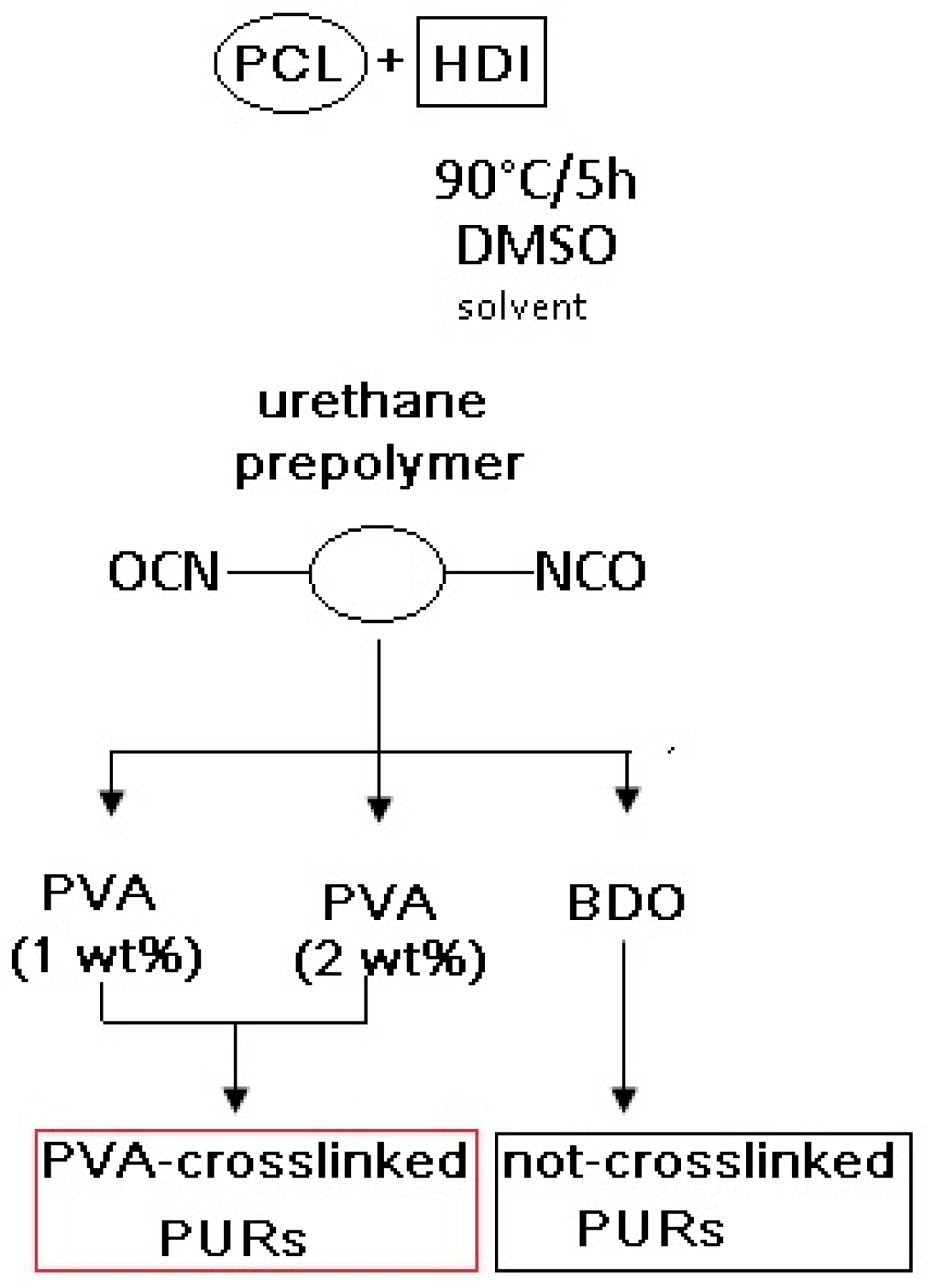
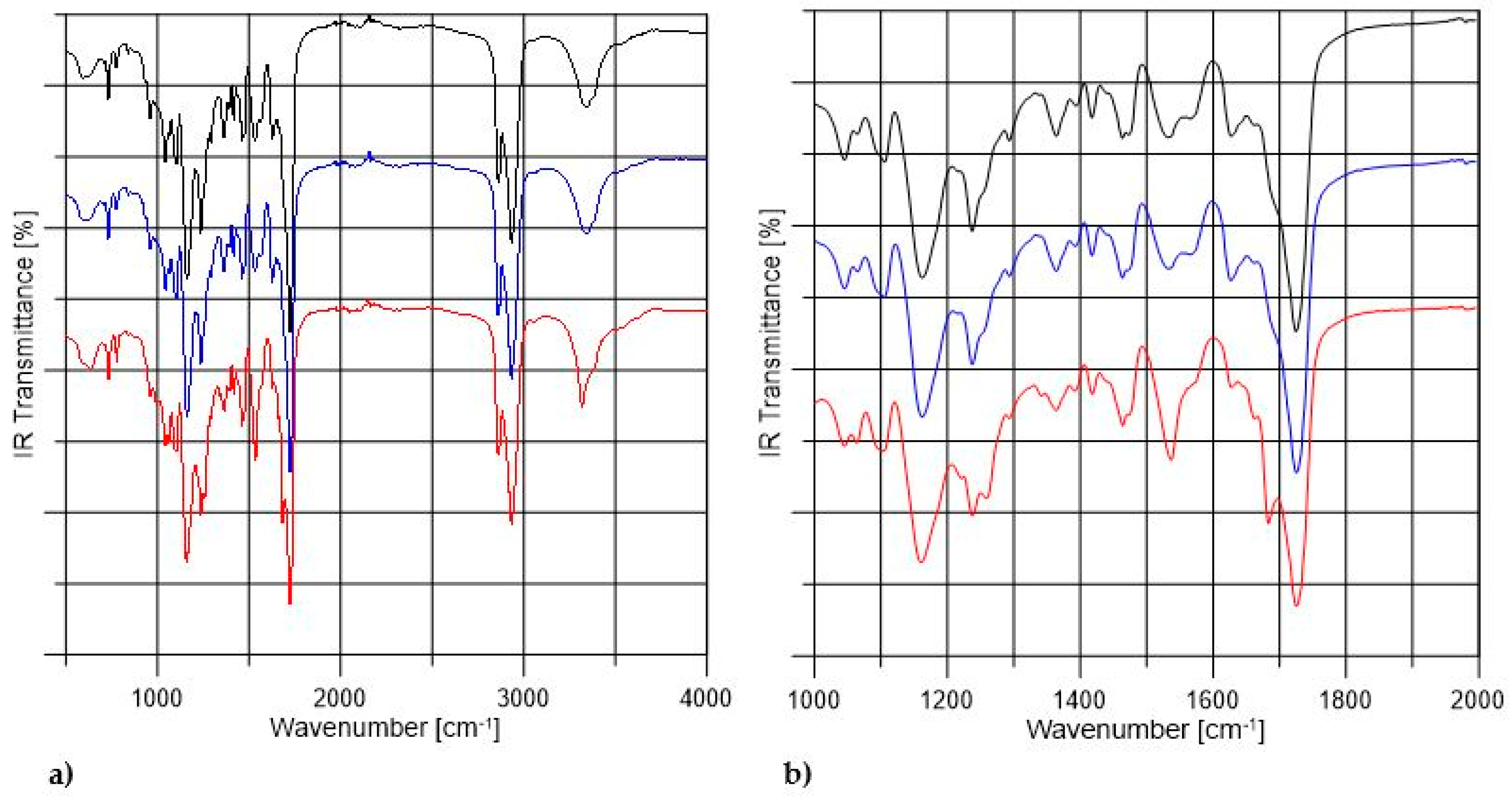

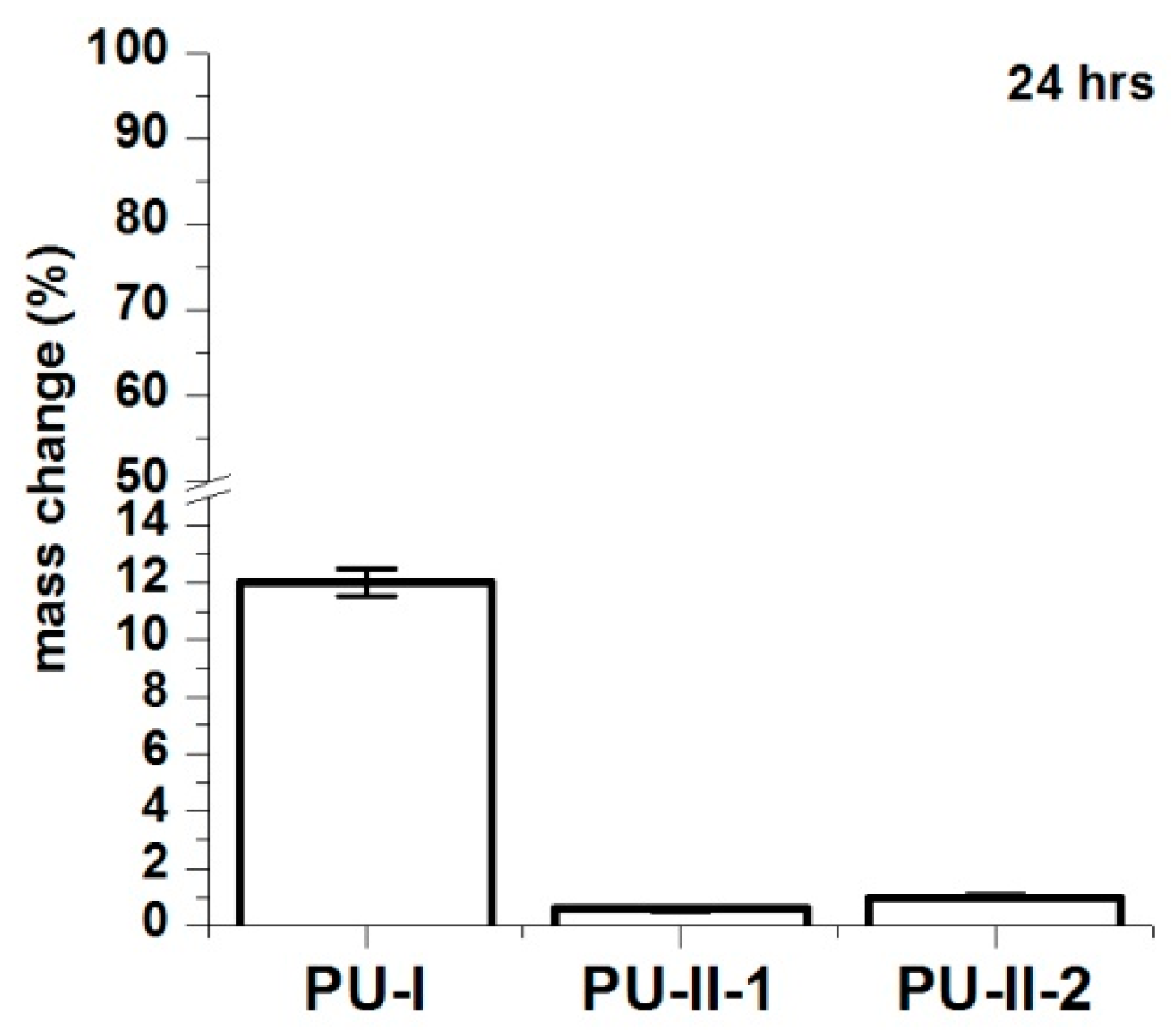

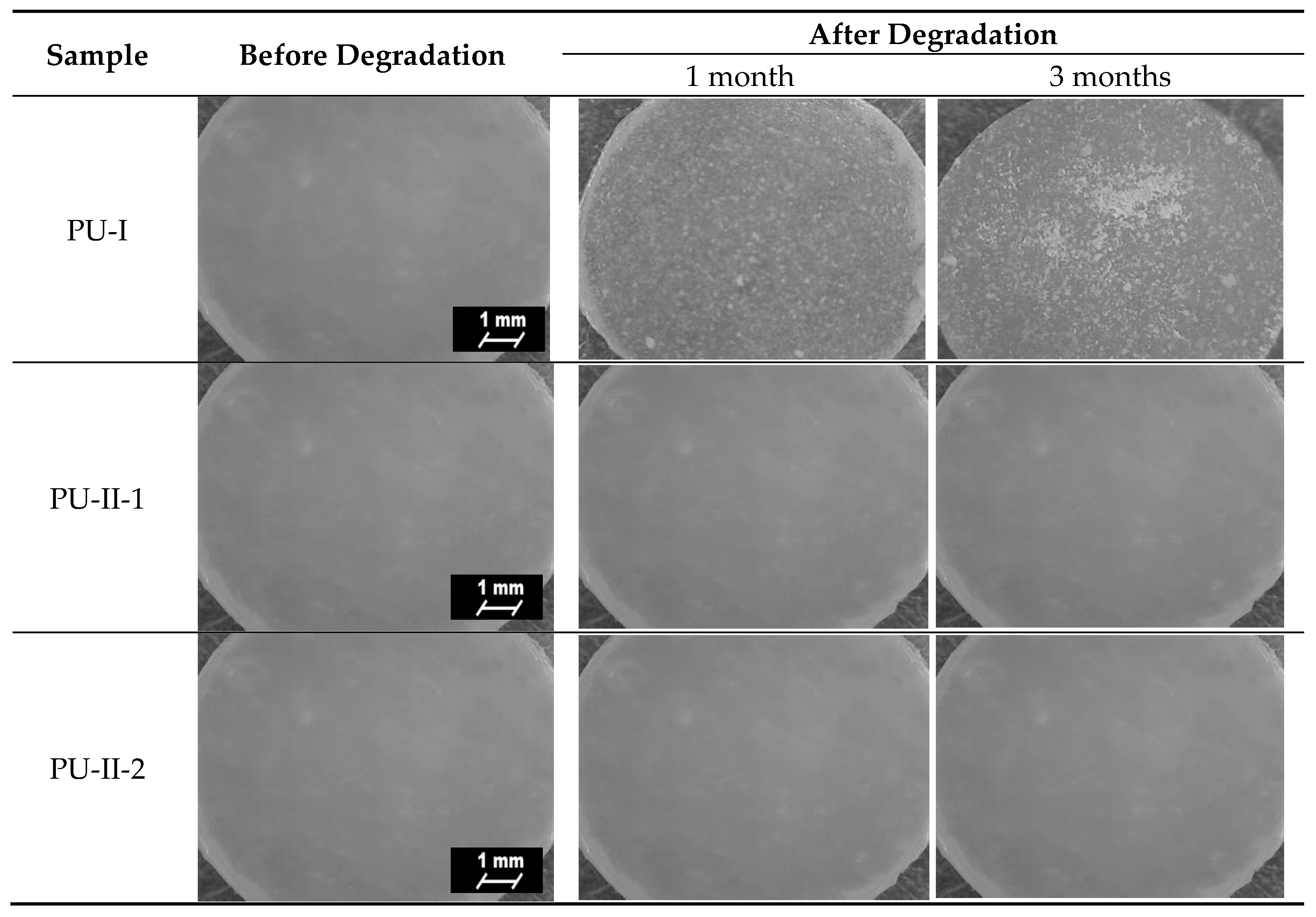
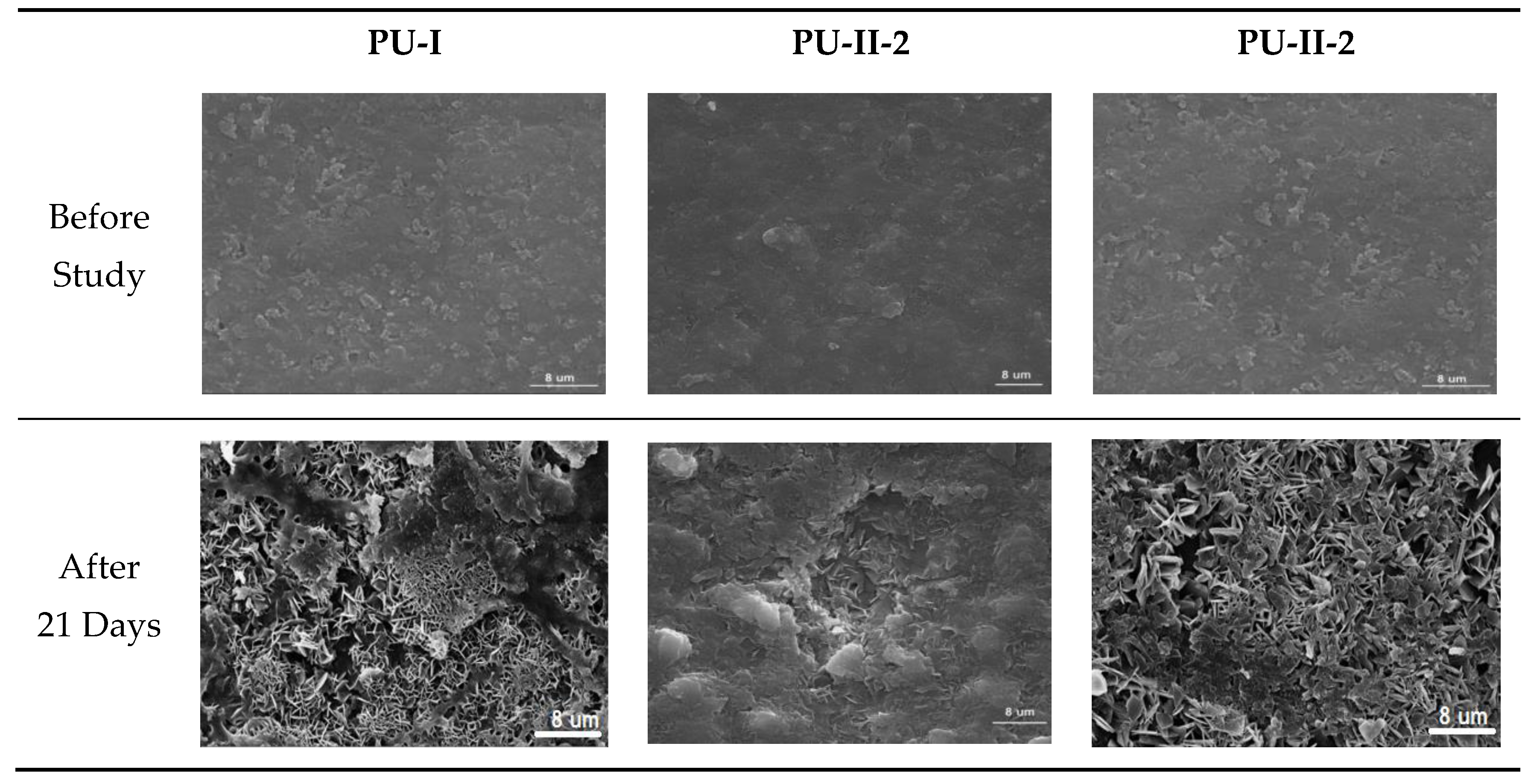



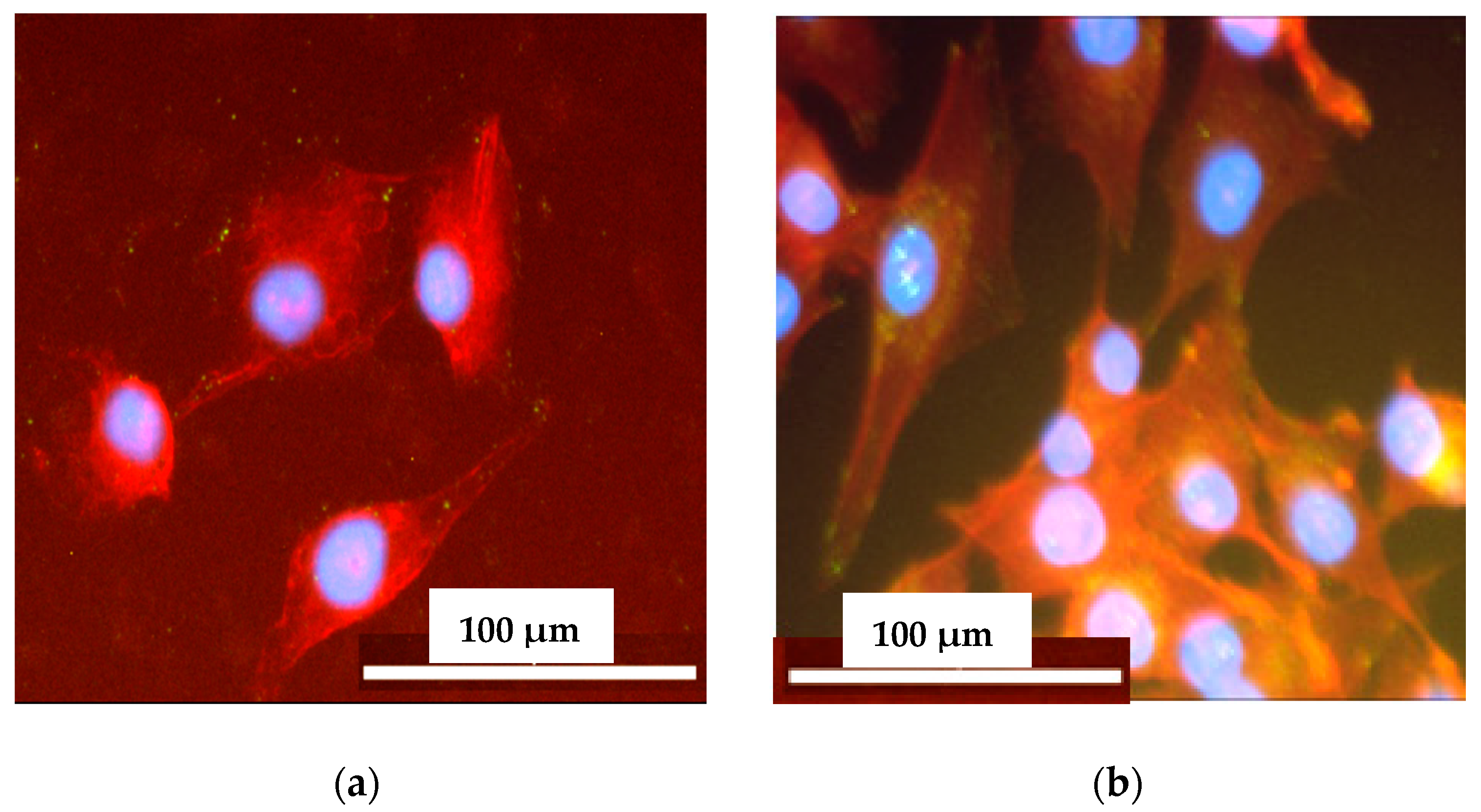
| Symbol | HDI (g) | PCL (g) | BDO (g) | PVA (g) | The Ratio of NCO:OH in the Prepolymer | Concentration of Free NCO Groups Present in the Prepolymer (%) |
|---|---|---|---|---|---|---|
| PU-I | 7.93 | 27.27 | 2.87 | - | 3:1 | 8.18 |
| PU-II-1 | 7.93 | 27.27 | - | 0.1 | 3:1 | 8.18 |
| PU-II-2 | 7.89 | 27.11 | - | 0.2 | 3:1 | 8.18 |
| Wavelength (cm−1) | Band Assignment | Description |
|---|---|---|
| 3350 m | νNH | Stretching of NH groups in urethane bond |
| 1730 vs | νC=O | C=O ester stretching in PCL soft segments |
| 1630 s | νC=O | C=O stretching in urethane hard segments R-NH-COO-R |
| 1570–1540 m | δCN | 2º amide N-H urethane deformation |
| 1240 m | νCN | C-N urethane stretching in hard segments |
| 1160 m | ν-(C=O)-O-C- | Combined asymmetric C-O-C stretching in urethane and PCL (Hard/soft segments) |
| 1100, 1080 w | ν-(C=O)-O-C- | Symmetric stretching of C-O-C groups in (1100) PCL/soft and (1080) urethane/hard segments. |
| Sample | Solubility in DMSO * | χ ** | Cross-Links Density (mol/cm3) |
|---|---|---|---|
| PU-I | + | − | − |
| PU-II-1 | − | 1.1979 | 31.12 × 10−4 |
| PU-II-2 | − | 1.3579 | 42.44 × 10−4 |
| Sample | Contact Angle (°) | ||
|---|---|---|---|
| Before | 1 Month | 3 Months | |
| PU-I | 59 ± 0.2 | 58 ± 0.2 | 57 ± 0.3 |
| PU-II-1 | 47 ± 0.1 | 46 ± 0.1 | 45 ± 0.2 |
| PU-II-2 | 38 ± 0.1 | 37 ± 0.1 | 37 ± 0.1 |
© 2018 by the author. Licensee MDPI, Basel, Switzerland. This article is an open access article distributed under the terms and conditions of the Creative Commons Attribution (CC BY) license (http://creativecommons.org/licenses/by/4.0/).
Share and Cite
Kucińska-Lipka, J. Polyurethanes Crosslinked with Poly(vinyl alcohol) as a Slowly-Degradable and Hydrophilic Materials of Potential Use in Regenerative Medicine. Materials 2018, 11, 352. https://doi.org/10.3390/ma11030352
Kucińska-Lipka J. Polyurethanes Crosslinked with Poly(vinyl alcohol) as a Slowly-Degradable and Hydrophilic Materials of Potential Use in Regenerative Medicine. Materials. 2018; 11(3):352. https://doi.org/10.3390/ma11030352
Chicago/Turabian StyleKucińska-Lipka, Justyna. 2018. "Polyurethanes Crosslinked with Poly(vinyl alcohol) as a Slowly-Degradable and Hydrophilic Materials of Potential Use in Regenerative Medicine" Materials 11, no. 3: 352. https://doi.org/10.3390/ma11030352



